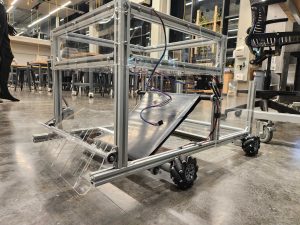This past week, I spent a significant amount of time finishing up the build for the robot, integrating electronic components, and testing the sensors and motors on the side. Primarily in preparation for interim demo, I placed a large focus on completing the construction for the robot (in terms of assembly and integration). I am very excited and grateful to have been able to finish assmebly of the roller mechanism (the clear roller that can be seen in the image below) and the other components, which include attachment and wiring of the wheels, build of the electronic component box (which consisted of attaching the rest of the acrylic boards to the side as well as the bottom), installation of the conveyor belt + additional piping on the linear shafts that connect the roller, and attachment of the stepper motors & motor mounts onto the vertical extrusions. This took quite some time, and Ritu and I worked together to attach the roller, the wheels, and the belt. Although it was relatively high intensive work in the hours that went in, I am excited about the final product. The work this week was integral to our overall progress on the capstone project.

There were a few issues with the robot actually working – the roller is able to pull the trash component inside the bot; however, there is difficulty in the trash object actually going up the ramp. Hence, we will be working on the addition of a small ramp to allow the mechanism to work after demo.
As the assembly was progressing this week, I worked on setting up circuitry for the ultrasonic sensor and testing the Adafruit Raspberry Pi hats. As planned, Ella and I tested the dc motors on the PI using the adafruit Pi hat (which we used as our motor driver) on Monday. As I had presumed, based on the power ratings of the motors (12 watts), a lower throttle (around 0.3) is sufficient for the dc motors which ran on 12V. We also tested the stepper motors, and unfortunately, due to, I believe inaccurate wiring, burned one of the integrated circuits on the hat. We brought two hats (one hat meant to drive the DC motors and one meant to drive the steppers), and so we decided to invest in a new hat for the stepper. This was a slight setback for what we had planned for interim demo; however, we still expect to display the build and the wheels moving.
This past Friday, after the assembly, Ella and I worked on testing the motor control code that I had also worked on this week. We ran into an issue of setting up ssh for the PI. This had to be done so that the code on the PI could be run externally (while it is connected to the robot). However, although we had set up a static IP address (to ssh), there seemed to be issues with CMU wifi allowing us to ssh into the PI. Sshing did not seem plausible after running through several articles; however, we looked into a few alternatives.
Our progress is on schedule. Although we’ve had a few setbacks, we’ve been working through each one with dedicated time. As for the hat, a new one has been ordered, and we will be testing each motor separately before integrating. For the ssh, I decided to set up the monitor (that I requested a few weeks ago) on the robot and run everything from there. That way, the display will work as a small monitor and we will not have to ssh (code will be updated using a Git repo). In the next week, I hope to demo our current project during the Interim demo and recieve feedback. I also hope to have the python code fully tested on the actual robot (not just sub-component testing of the motors on the pi) and fix slight issues with the pick up mechanism. I will also be working on research on VSLAM so that we can get started on writing the algorithm “to get back home.”
0 Comments